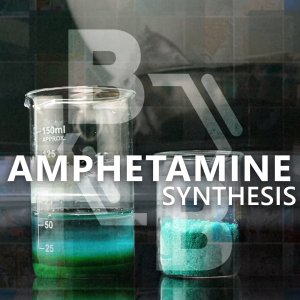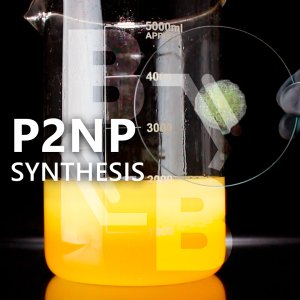You should upgrade or use an alternative browser.
1-Phenyl-2-nitropropene (P2NP) Synthesis and Purification
1-Phenyl-2-nitropropene (P2NP) Synthesis and Purification
Reaction scheme:
Equipment and glassware:
- 10 L Flask;
- Retort stand and clamp for securing apparatus (optional);
- Reflux condenser;
- Funnel;
- Vacuum source;
- Laboratory scale (0.1-500 g is suitable) - optional;
- Measuring cylinders 1000 mL and 100 mL;
- Water bath;
- Glass rod and spatula;
- Filter paper;
- Laboratory grade thermometer;
- Buchner flask and funnel;
- Bucket 5-10 L.
- Freezer;
Reagents:
- Benzaldehyde 1000 ml;
- Nitroethane 1000 ml;
- Glacial acetic acid 250 ml;
- n-Butylamine 50 ml;
- Isopropyl alcohol (IPA) ~1000 ml;
Medium scale
1. Benzaldehyde 1000 ml, nitroethane 1000 ml, glacial acetic acid 250 ml and n-butylamine 50 ml are placed into 10 L flask.
2. A reflux condenser is installed onto the flask.
3. The stirrer and heater are turned on. The reaction mixture is heated up to 60 °С.
4. The reaction is conducted during 2-3 hours with constant stirring at 60 °С.
5. The reaction mixture is poured into an empty 5-10 L bucket.
6. Isopropyl alcohol (IPA) 800 ml is poured into the bucket and stirred.
7. The bucket with mixture is put into a freezer for 12 hours, 1-phenyl-2-nitropropene (P2NP) is crystallized.
8. The product P2NP is filtered on a Buchner funnel (suction filtration procedure), washed be a small amount of cold IPA and dried on air (or in vacuum chamber, optional).
Equipment and glassware:
- Beaker 500 ml;
- Funnel;
- Vacuum source;
- Laboratory scale (0.1-500 g is suitable) - optional;
- Measuring cylinders 50 mL and 100 mL;
- Glass rod and spatula;
- Filter paper;
- Buchner flask and funnel;
- Freezer;
- Microwave oven 750 W;
Reagents:
- Benzaldehyde 100 ml;
- Nitroethane 100 ml;
- Glacial acetic acid 25 ml;
- n-Butylamine 20 ml;
- Isopropyl alcohol (IPA) ~150 ml;
Microwave (small) scale
1. Benzaldehyde 100 ml, nitroethane 100 ml, glacial acetic acid 25 ml and n-butylamine 20 ml are placed into 500 ml beaker.
2. A rubber glove is put onto the beaker.
3. The beaker is put into a microwave oven.
4. The power of the microwave oven is set up on 750 W. Oven is turned on and the mixture is warmed until the boiling. The mixture is cooled down to the room temperature.
5. Step 4 is repeated several times. Minimum 6 times.
6. Next, IPA 100 ml is added, reaction mixture is stirred and put into a freezer for 12 hours. 1-Phenyl-2-nitropropene (P2NP) is crystallized.
7. The product P2NP is filtered on a Buchner funnel (suction filtration procedure), washed be a small amount of cold IPA and dried on air (or in vacuum chamber, optional).
1-Phenyl-2-nitropropene (P2NP) Purification by Recrystallization
1-Phenyl-2-nitropropene (P2NP) can be recrystallized from hexane, methanol, ethanol or isopropanol (IPA).
-

Would it be possible to methylate beta-nitrostyrene to obtain P2NP?
I am a mere amateur in chemistry, so I was thinking about something: In my country, it is more likely to obtain nitromethane than nitroethane. Therefore, I tried to do the condensation of Henry with nitromethane, but unfortunately this condensation generates beta-nitrostyrene, which has this...- TeslaSec
- Thread
- nitromethane nitrostyrene p2np synthesis
- Replies: 2
- Forum: Precursors
-

3,4,5-Trimethoxy - P2NP 99.9% CAS: 5556-76-3
1-(3,4,5-Trimethoxyphenyl)-2-nitropropene is a high quality chemical that is a reagent and useful intermediate. It has been shown to be a useful scaffold for the synthesis of various compounds and as a building block for the synthesis of speciality chemicals. This compound can be used in...- ChemicaIs4you
- Resource
- p2np synthesis
- Category: Nitro compounds
-

SYNTHESIS OF 3,4,5 TRIMETHOXY-P2NP FROM NITROETHANE AND 3,4,5 TRIMETHOXYBENZALDEHYDE
First of all I want to thank G. Patton and WillD for their support and chemical knowledge that helped me get very good results of synthesis with great success for the first time. This synthesis can be used for different types of benzaldehydes that are in powder form and instead of nitroethane...- ChemicaIs4you
- Thread
- p2np synthesis
- Replies: 7
- Forum: Precursors
-

1-Phenyl-2-nitropropene(P2NP)CAS:705-60-2
1-Phenyl-2-nitropropene(P2NP)CAS:705-60-2 We are the RC Lab team, we are manufacturers of starting materials and research chemicals and we are committed to providing quality products to our customers. Long-term cooperation is our goal. 1-Phenyl-2-nitropropene, also called P2NP, is our...- Simon
- Resource
- p2np p2np al hg p2np recrystallization p2np synthesis p2p synthesis from p2np
- Category: Nitro compounds
-

P2NP Recrystallization
1-Phenyl-2-nitropropene (P2NP) recrystallization via IPA (isopropyl alcohol). https://bbgate.com/threads/1-phenyl-2-nitropropene-p2np-video-synthesis-from-benzaldehyde-and-nitroethane-henry-reaction.52/- Novator
- Media item
- 1-phenyl-2-nitropropene 1-phenyl-2-nitropropene recrystallization 1-phenyl-2-nitropropene video amphetamine breaking bad p2np p2np recrystallization p2np synthesis recrystallization stimulant
- Comments: 9
- Category: Synthesis of Amphetamines (Phenylethylamines)
-

Amphetamine synthesis
Amphetamine synthesis via NaBH4 reductive amination from P2NP. https://bbgate.com/threads/one-pot-amphetamine-synthesis-from-p2np-with-nabh4-cucl2-1kg-scale.70/- Novator
- Media item
- amphetamine amphetamine synthesis nabh4 p2np p2np synthesis phenyl-2-nitropropene video synthesis
- Comments: 97
- Category: Synthesis of Amphetamines (Phenylethylamines)
-

1-Phenyl-2-nitropropene synthesis
Benzaldehyde and nitroethane Henry condensation. https://bbgate.com/threads/1-phenyl-2-nitropropene-p2np-video-synthesis-from-benzaldehyde-and-nitroethane-henry-reaction.52/- Novator
- Media item
- 1-phenyl-2-nitropropene amphetamine benzaldehyde cas 100-52-7 cas 705-60-2 henry reaction nitroethane p2np p2np synthesis phenyl-2-nitropropene video synthesis
- Comments: 50
- Category: Synthesis of Amphetamines (Phenylethylamines)
-

1-Phenyl-2-nitropropene (P2NP) Video Synthesis From Benzaldehyde and Nitroethane. Henry Reaction.
Reaction scheme: Equipment and glassware: 10 L Flask; Retort stand and clamp for securing apparatus (optional); Reflux condenser; Funnel; Vacuum source; Laboratory scale (0.1-500 g is suitable) - optional; Measuring cylinders 1000 mL and 100 mL; Water bath; Glass rod and spatula; Filter...- GhostChemist
- Thread
- 1-phenyl-2-nitropropene benzaldehyde cas 100-52-7 cas 705-60-2 cas 79-24-3 henry reaction nitroethane p2np p2np synthesis phenyl-2-nitropropene video synthesis
- Replies: 288
- Forum: Precursors
About Us
Our team brings together the best specialists from different fields.
We are ready to share our experience, discuss difficult issues and find new solutions.
